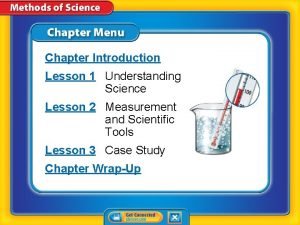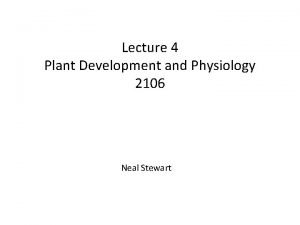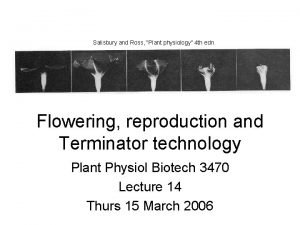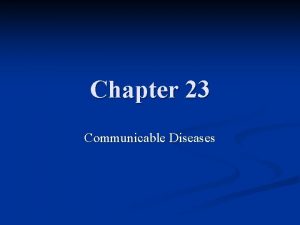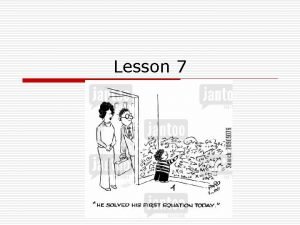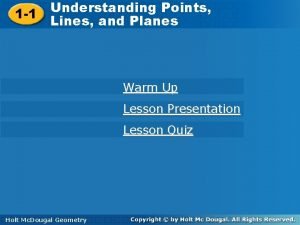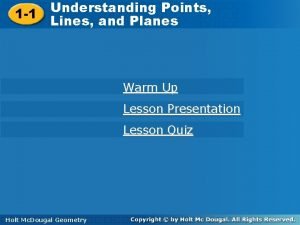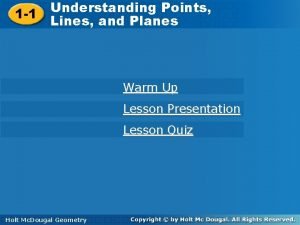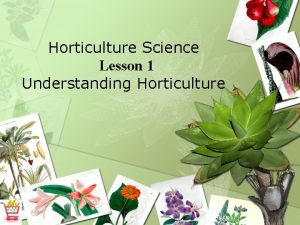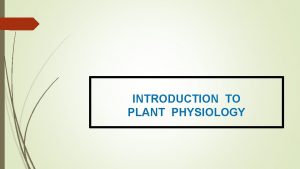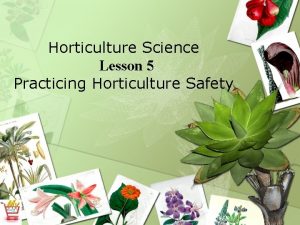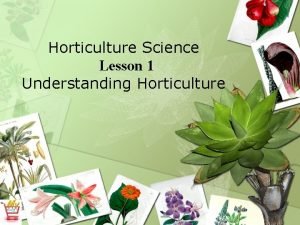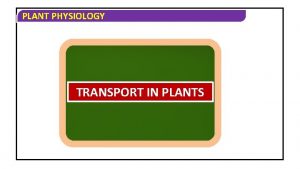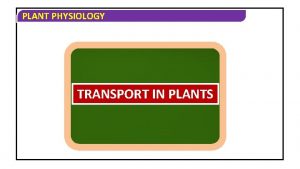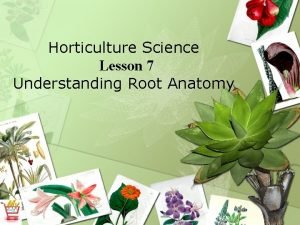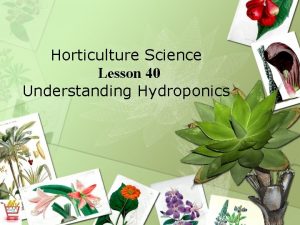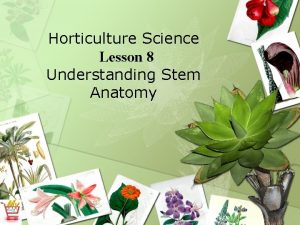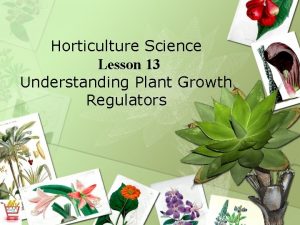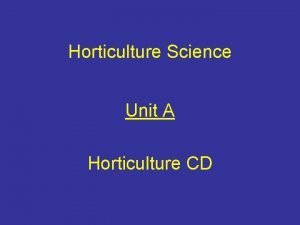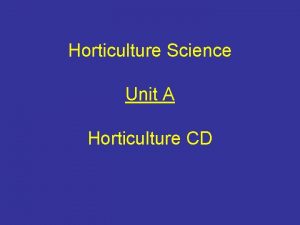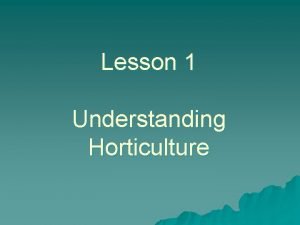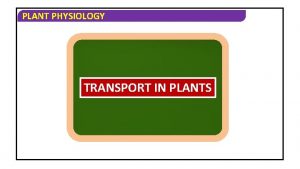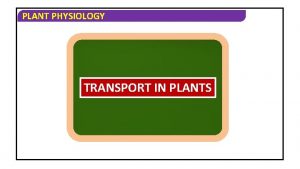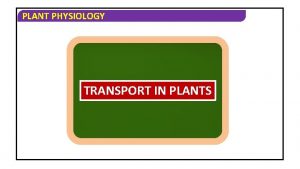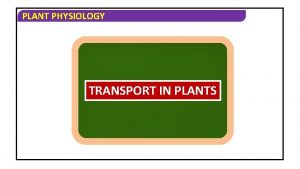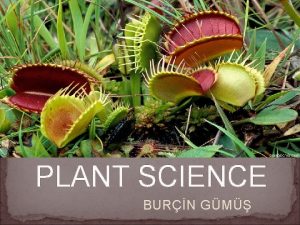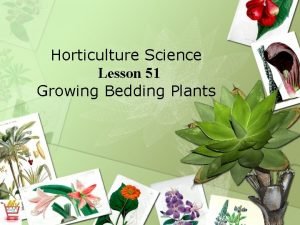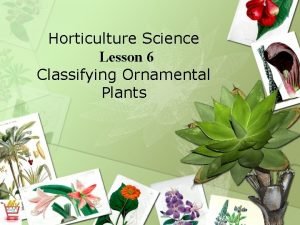Horticulture Science Lesson 11 Understanding Plant Physiology Interest































- Slides: 31

Horticulture Science Lesson 11 Understanding Plant Physiology

Interest Approach Bring a drinking glass to class. Either teach briefly or ask students to come up with a simple equation for photosynthesis, such as “carbon dioxide and water give you sugar and oxygen”. Partially fill the glass with water and ask for an easy carbon dioxide source. When your breath is suggested, breathe out into the container, thus “combining” water and carbon dioxide.

Interest Approach Cover the container with your hand shake it vigorously. After anywhere from 5 to 60 seconds of shaking, stop and take a drink. State that the equation must be true because you just tasted the water and it was sweet. This will prompt an active discussion on how this is or is not possible. Stick to your story as long as necessary.

Interest Approach Another approach is to talk to a student before class and have the student play along, first as an unbeliever and then as a convert. You may lace another drinking glass with sugar syrup so that when you fill it up with tap water it tastes sweet. The object of the deception is to get the students to think of exactly what it takes to produce sugar. Of course, it only happens in plants.

Student Learning Objectives • Analyze the process of photosynthesis. • Examine the process of cellular respiration.

Student Learning Objectives • Describe plant growth processes. • Explain why photosynthesis and respiration are important to human beings.

Terms • • ATP cellular respiration cellulose chlorophyll chloroplast enzymes fructose

Terms • • glucose metabolism mitochondria NADPH photosynthesis starch transpiration

How does photosynthesis work? • Photosynthesis is the process by which a plant turns the light energy from the sun into chemical energy in the form of sugar. • Photosynthesis is a complex series of chemical reactions that happens within the plant cells. • The photosynthetic process can be broken down into two stages: the light reaction and CO 2 fixation.

How does photosynthesis work? • The process of producing food begins with the light reaction phase. • Light energy is trapped and used to fuel the photosynthetic process. • The harnessing of light energy is made possible by pigments found in chloroplasts, which are specialized organelles within the individual plant cells. • As light enters the chloroplast, chlorophyll, carotene, and xanthophylls, pigments absorb the energy.


How does photosynthesis work? • Chlorophyll, the primary pigment involved in the manufacture of food, uses the light energy to make the highenergy compounds ATP and NADPH. – These compounds power reactions in the cells.

How does photosynthesis work? • Chlorophyll uses the energy to split water molecules, H 2 O, during the first phase of the photosynthetic reaction. • Oxygen atoms from water molecules bond to form O 2. The O 2 escapes through the stomata into the atmosphere. • Hydrogen atoms from the water molecule are incorporated into sugar molecules as the process continues in CO 2 fixation.

How does photosynthesis work? • During the CO 2 fixation phase of the photosynthetic reaction, energy in the form of ATP and NADPH is used to form sugars. • Carbon dioxide enters through the stomata and is available to the chlorophyll in the cells.

How does photosynthesis work? • The CO 2 combines with hydrogen from the water molecule. • Two forms of sugar, glucose and fructose (C 6 H 12 O 6), are assembled. • Although they both have the same formula, the molecular structures differ.

How does photosynthesis work? • Glucose and fructose fuel plant growth. • They are the source of energy for the plant’s life processes. • All live cells in the plant benefit as the sugars are transported through the phloem to the rest of the plant. • The simple sugars can also be combined to form a more complex sugar: sucrose (C 12 H 22 O 11).

How does photosynthesis work? • The sugar molecules may be processed further to form starch and cellulose. • These are huge molecules, resulting from the bonding of thousands of glucose molecules. • Starch serves as the principle way in which food is stored for plants. • When needed, it is easily broken down into glucose or converted into other plant products by plant enzymes.

How does photosynthesis work? • The cellulose is applied to cell walls for strength and rigidity. • Once sugars are converted to cellulose, they are not reclaimed for other purposes.

How does cellular respiration work? • In many ways, cellular respiration is the opposite of photosynthesis. • Photosynthesis stores energy in chemical bonds in the process of making sugars. • Energy stored in the chemical bonds is released during cellular respiration.

How does cellular respiration work? • Cellular respiration takes place in structures contained within cells called mitochondria. • Cellular respiration is extremely important in the growth and development of plants. • All living plant cells respire or use energy to live and function.

How does cellular respiration work? • Cellular respiration involves sugars produced in the photosynthetic process along with oxygen and water. • In the reaction, chemical energy is released when the molecular bonds of the sugar molecules are broken in combination with oxygen gas.

How does cellular respiration work? • The extracted energy, ATP, drives a variety of chemical reactions in the cell. • By-products of the reaction include carbon dioxide and water. • Water and carbon dioxide are released, as is all of the energy that was contained in the bonds of the glucose molecule.

How does cellular respiration work? A COMPARISON OF PHOTOSYNTHESIS AND RESPIRATION

How does plant growth occur? • Actual plant growth is fueled by cellular respiration. • It takes place primarily at night when photosynthesis is shut down. • With signals from hormones, enzymes or chemical activators are produced. • Each enzyme has a specific job.

How does plant growth occur? • With split-second timing, enzymes break down sugars and recombine them with nitrogen and other minerals. • Many complex molecules are produced, which include starches, pectin (to bind cells), lignin (a tough, durable substance), cellulose, lipids (fats), proteins, pigments, hormones, vitamins, and alkaloids, and tannins (materials that protect plants from pests and diseases).

How does plant growth occur? • All of the chemical reactions in a plant fall under a term: metabolism. • The speed at which chemical reactions occur is influenced by temperature. • Plant metabolism is slowed in cool or cold temperatures and is more rapid in warmer temperatures. • For example, florists keep cut flowers in coolers to slow metabolism that leads to aging.

How does plant growth occur?

How are photosynthesis and respiration important to human beings? • Photosynthesis and cellular respiration are two of the most important chemical reactions to human beings. • All of our food and nutrition comes either directly or indirectly from photosynthesis. • We eat a combination of plants and things that ate plants. • Much of our heat and electricity comes either directly or indirectly from byproducts of photosynthesis in plants.

How are photosynthesis and respiration important to human beings? • Fossil fuels that power our vehicles have their origin in plants. • Most of the oxygen that we breathe comes from photosynthesis reactions. • Transpiration is the release of water from leaves as part of photosynthesis. • It puts thousands of tons of water into the air, cooling our environment and encouraging rainfall.

Review/Summary • How does photosynthesis work? • How does cellular respiration work?

Review/Summary • How does plant growth occur? • How are photosynthesis and respiration important to human beings?
 Measurement and scientific tools lesson 2 answer key
Measurement and scientific tools lesson 2 answer key Lesson 1 understanding science answer key
Lesson 1 understanding science answer key Lesson 2 measurement and scientific tools answer key
Lesson 2 measurement and scientific tools answer key International horticultural society
International horticultural society International horticulture society
International horticulture society Physiology
Physiology Plant physiology
Plant physiology Salisbury and ross plant physiology
Salisbury and ross plant physiology Nominal v. real interest rates
Nominal v. real interest rates Effective interest rate
Effective interest rate Compound interest multiplier
Compound interest multiplier Science
Science International anatomy olympiad
International anatomy olympiad Science olympiad forensics cheat sheet
Science olympiad forensics cheat sheet Introduction in plant breeding
Introduction in plant breeding Plant breeding for disease resistance
Plant breeding for disease resistance Plant introduction in plant breeding
Plant introduction in plant breeding Tronsmo plant pathology and plant diseases download
Tronsmo plant pathology and plant diseases download Tronsmo plant pathology and plant diseases download
Tronsmo plant pathology and plant diseases download Tronsmo plant pathology and plant diseases download
Tronsmo plant pathology and plant diseases download Chapter 9 lesson 3 understanding violence
Chapter 9 lesson 3 understanding violence Chapter 23 lesson 1 understanding communicable diseases
Chapter 23 lesson 1 understanding communicable diseases Writing literal equations
Writing literal equations Chapter 4 lesson 1 understanding stress
Chapter 4 lesson 1 understanding stress Chapter 1 understanding health and wellness lesson 4
Chapter 1 understanding health and wellness lesson 4 Chapter 1 understanding health and wellness lesson 2
Chapter 1 understanding health and wellness lesson 2 Chapter 1 lesson 2 what affects your health
Chapter 1 lesson 2 what affects your health Understanding points lines and planes
Understanding points lines and planes Understanding points lines and planes
Understanding points lines and planes Geometry lesson 1-1 answers
Geometry lesson 1-1 answers Lesson 2 understanding limits graphically and numerically
Lesson 2 understanding limits graphically and numerically 1-1 understanding points lines and planes
1-1 understanding points lines and planes


